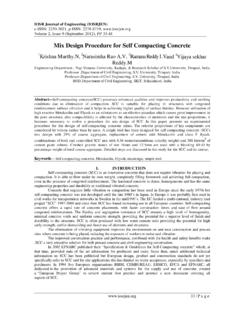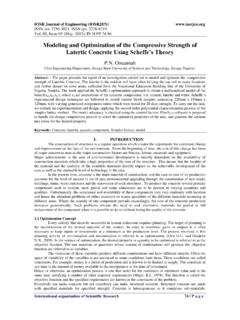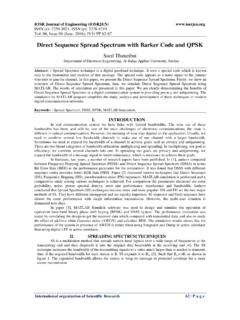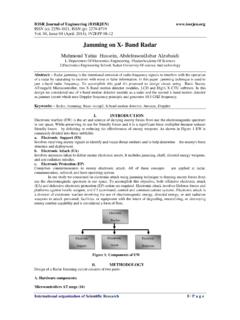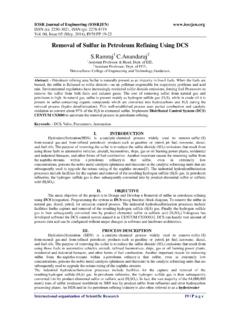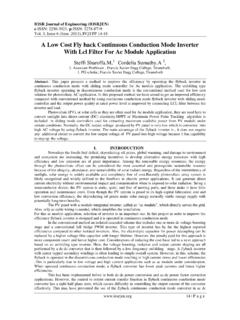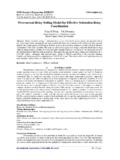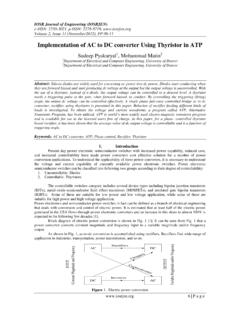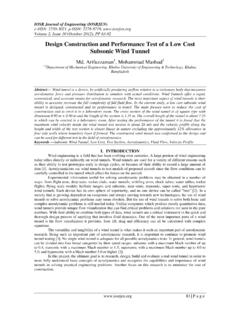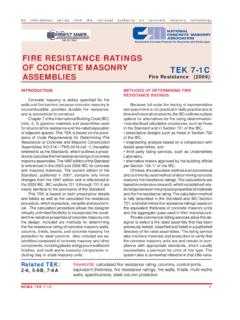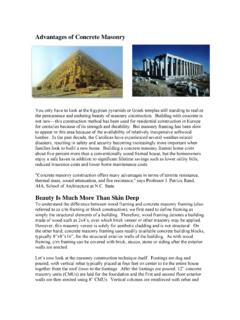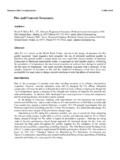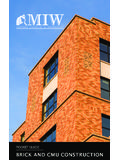Transcription of Load Carrying Capacity of Hollow Concrete Block …
1 IOSR Journal of Engineering (IOSRJEN). e-ISSN: 2250-3021, p-ISSN: 2278-8719, Volume 2, Issue 10 (October 2012), PP 05-08. Load Carrying Capacity of Hollow Concrete Block masonry Column Mr. M K Maroliya. Assistant professor, Applied Mechanics Dept, Faculty of Technology & Engineering, University of Baroda, Vadodara, Abstract Stability plays an important role but Economy of structure is one of the basic aspect upon which any design is based however, best designer is one who comes out with a design which gives the stable and economic structure .the development of construction technology is closely related to the development of adequate mechanization and handling technology. Hollow Concrete Block is an important addition to the types of masonry units available to the builder and its use for masonry is a constantly increases.
2 This project is a study of construction of Hollow Concrete Block masonry , Columns constructed with Hollow Concrete blocks, and to the load Carrying Capacity of the Hollow Concrete Block individually and when used in the masonry work, by comparing the work with brick masonry this will help builders to appreciate the essential constructional details and adopt Hollow Concrete Block masonry in a large scale wherever it is economical. Key words masonry , Hollow Concrete Block , strength of masonry I. INTRODUCTION. Shelter is one of the three basic requirements of human being. Initially ancient man started living in caves excavated below ground level on near the hill ends .thereafter, they started constructing walls from mud, and in due course of time, the developed the techniques of burnt clay brick masonry to form the structural part of the shelter.
3 The desire for search of new structural materials paved the way for Hollow Concrete blocks due to following advantages 1. Adequate strength and structural stability. 2. Superior thermal insulation and acoustic characteristics. 3. Sound control. 4. Resistance to fire. 5. Light weight. 6. Speedy work. 7. Economy Building construction is a multi disciplined technology. It involves an exchange of thoughts, experience and ideas among those engaged in the various disciplined of the construction activity in order to achieve overall economy and proper serviceability of the construction project at hand. It should also make use of innovative methods in the field of material technology by the use of improved materials resulting in the production of economical, aesthetically acceptable and durable structure.
4 The resistance to any change comes not only from the artisans and makers but even from engineers, contractors, owners and public in general. It is a human attitude of unwillingness to come out of a well established route. The modern recommended practice is to dispense with several on the spot' operations and replace them with the manufactured materials. That site operation are often left to workers who do not have the skills to the desirable extent and cannot be adequately supervised, resulting in such work often being sheddy and expensive. Economical and efficient construction techniques demand excellent micro-planning, determining as to which of the building materials should be manufactured on a mass scale, setting out and promoting such manufacturing facilities and popularizing their use.
5 The development of construction technology is closely related to the development of adequate mechanization and handling technology, the latter involves both the provisions of equipment as well as the handling dexterity. Hollow Concrete Block is an important addition to the types of masonry units available to the builders and its use for masonry a constant increases, some of the advantages of Hollow Concrete Block construction are 5|Page Load Carrying Capacity of Hollow Concrete Block masonry Column reduced mortar consumption, light weight and greater speed of masonry work. Work compared with brick masonry . Since may builders are yet to become familiar with the use of Hollow Concrete blocks, this will help them to appreciate the essential constructional details and adopt Hollow Concrete Block masonry in a large scale wherever it is economical.
6 II. EXPERIMENTAL PROGRAM. This project is a study of construction of Hollow Concrete Block masonry . The emphasis in the present study is given to study the crack patterns developed in the structural elements like columns constructed with Hollow Concrete blocks, and to the load Carrying Capacity of the Hollow Concrete Block individually and when used in the masonry work. There different columns of size of cross sectional area 400 x 400 mm and meter height were also tested in the compression testing machine. All the three columns were constructed by joining the blocks with mortar 1:3. One column was kept Hollow inside, one was made solid by filling mortar of 1:3 proportion cement Concrete . It was noted that the strength of the Hollow column is increased significantly when it was made solid by filling the Hollow portion by cement-sand, mortar.
7 But putting mortar inside the Hollow portion by soil, which is easily available and is not a cost influencing factor, the strength of the Hollow columns can be increased by them solid, thus making them economical also. The Hollow Concrete blocks are tested in compression testing machine. The bearing surfaces of the compression testing machine are wiped clean and any dry loose or other materials are removed. The Hollow Concrete blocks taken out from the curing and are allowed to dry for 24 hours in open air. The dimensions of the Hollow blocks are measured to the nearest mm and their weighs are noted before testing. The two surfaces of each Block that would normally be placed horizontally in the wall are termed as faces. The load is applied in these bed faces. The axis of the bed face is carefully aligned with the centre of spherically seated plate.
8 No packing is used between the faces of the test specimen and the steel plate of the testing machine. As the spherically seated Block is brought to bear on the specimen, the movable portion is rotated gently by hand so that uniform seating may be obtained. The load is applied without shock and increased continuously at a rate of approximately 140 until the resistance of Hollow Concrete blocks to the increasing load breaks down and greater load can be sustained. The load applied to Block and any unusual features in the type and failure are noted. The maximum load in kilograms supported by the Block before failure on square centimeter will be taken as the compressive strength of the Block . The mean of the compressive strength of the three blocks will be taken as the compressive strength of batch compressive strength less than 75% of the mean value so obtained.
9 Mortar should be spread over the entire top surface of the Block including front and rear shells as well as the webs to a uniform layer of one centimeter thickness. Normally full mortar bedding should be adopted as it enables fuller utilization of the load Carrying Capacity of the blocks. But where the walls carry right loads such as panel walls in framed structure face shell bedding may be used. In this type of bedding the mortar is spread only over the front and rear shells and not the web which helps to arrest the seepage of water through the joints penetrating to the interior surface of the walls For vertical joints the mortar should be applied on the vertical edges of the front and rear shells of the blocks. The mortar may be applied either to the unit already placed on the wall or to the next unit to be laid along with to be laid alongside of it.
10 But it will more convenient to apply mortar in the edges of the succeeding unit when it is standing vertically and then placing it horizontally well pressed against the previously laid unit however whatever the method used for applying mortar care must be taken to produced well compacted vertical joints. In the case of two cell blocks there is a slight depression on their vertical sides which may also be filled up with mortar where it is considered necessary to secure greater lateral rigidity. Mortar should not be spread so much a head of the actual laying of the units that it tends to stiffen and lose its plasticity thereby resulting in poor bond. For most of the work the joints both horizontal and vertical should be one centimeter thick. Expect in the case of extruded joint construction the mortar should be raked out from the joint with a trowel to a depth of about one centimeter as each course is laid so as to ensure good bond for the plaster.
